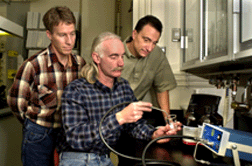|
Sandia’s portable chemical vapor detection system being prepared for ‘big’ test
Technology may be used for drug detection, environmental monitoring
|

READY FOR FIELD TESTING — Sandia researchers Graham Yelton (left) and Richard Cernosek (right) watch as Alan Staton conducts a lab test using Sandia's lightweight portable chemical vapor detection system. It is now being refined in preparation for field testing in a chemical plume in 2001. (Photo by Randy Montoya)
Download 300dpi JPEG image, ‘sniffer.jpg’, 1.6MB (Media are welcome to download/publish this image with related news stories.)
|
ALBUQUERQUE, N.M. — A lightweight, portable chemical vapor detection system developed by the Department of Energy’s (DOE) Sandia National Laboratories is in final preparation for the big test — a field test simulating a chemical release. The system is designed to identify chemical signatures from weapons of mass destruction.
A team of researchers has worked on the project for more than five years and is now completing the laboratory demonstration phase of the detection system. Field testing of a second unit is expected next year, putting the technology within a few years of actual deployment.
“There is much interest in this detection technology — by the military, the Environmental Protection Agency, DOE and other government agencies and many private enterprises,” says Richard Cernosek, project lead. “The technique is adaptable for a variety of applications ranging from environmental monitoring and remediation to industrial process control and from personal health and safety to law enforcement and drug detection.”
The seven-pound, battery-powered sensor system, built into a box 10 by 8 by 4 inches, along with its notebook computer is light enough to be hand-carried into the field where it can test for and identify 18 different chemicals in minutes.
Cernosek says the system’s light weight and ability to test for a multitude of chemicals make it a significant step in the area of vapor detection.
In the not-so-distant past, chemical samples had to be taken in the field and then to a laboratory for testing, meaning a considerable delay before chemical information is available. Many situations, such as military applications, demand on-the-spot chemical analyses.
This new system — which can test for chemical signatures related to the three categories of weapons of mass destruction: nuclear, chemical, and biological — is part of a new generation of chemical vapor detection technology.
“This system has many desirable properties of a portable chemical detector,” Cernosek says. “It is sufficiently sensitive to determine chemical concentrations at relevant levels. It can identify chemicals with a high degree of accuracy. It has rapid response for timely determination of information. It isn’t affected by changes in temperature and humidity. It is compact and uses low power, making it suitable for field applications. And it can be produced at a low cost.”
The heart of the detection system is an array of seven surface acoustic wave (SAW) sensors, each with a different chemically sensitive thin film coating. The substrate of the sensors is quartz, cut at a crystalline angle that supports a surface wave. As a piezoelectric material, the quartz converts electric signals to surface acoustic waves that travel much like waves on water. A thin, selectively absorbing layer is coated on the quartz surface. When specific chemical molecules sorb into or onto this layer, the acoustic waves travel more slowly. This change can be detected by the sensor microelectronics once the acoustic wave is converted back to an electric signal.
Because each sensor is coated with a distinct chemically sensitive layer, the sensors will respond differently to the same chemical, forming a recognizable pattern. The data from all the sensors are put into a Sandia-developed pattern-recognition algorithm, a computational program called Visual Empirical Region-of-Influence (VERI), which uses a clustering technique to identify the various chemicals. The VERI algorithm has proven to be very good in discriminating among different chemicals. The algorithms can identify 18 different volatile organic compounds over a wide concentration range with a 95 percent accuracy.
The sensor array is contained in a small, sealed, temperature-controlled case with electrical connections and gas flow ports. The array itself can be removed from the case, allowing sensor arrays to be customized for particular applications. A small diaphragm pump pulls vapor samples from the environment through the test cavity. The system uses a Windows-based notebook computer for system control, real-time display, data storage, and pattern recognition.
The researchers have so far tested the system only in a laboratory setting using chemicals in vials and beakers. They are refining its capabilities — the pattern recognition and sensor array — to increase performance and prepare for field testing in a chemical plume in 2001.
“Then we’ll see this system operate in a realistic setting,” Cernosek says. “It’s been several years in the development and preparation. We should be ready for this.”
Project funding comes from the DOE Nonproliferation and National Security Office of Research and Engineering.
Sandia is a multiprogram laboratory operated by Sandia Corporation, a Lockheed Martin Company, for the United States Department of Energy under contract DE-AC04-94AL85000. With main facilities in Albuquerque, N.M., and Livermore, Calif., Sandia has major research and development responsibilities in national security, energy and environmental technologies, and economic competitiveness.
Media contact:
Chris Burroughs, coburro@sandia.gov, (505) 844-0948
Technical contact:
Richard Cernosek, rwcerno@sandia.gov, (505) 845-1198
|
